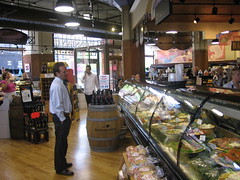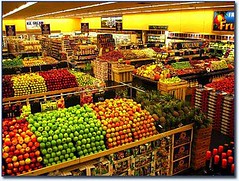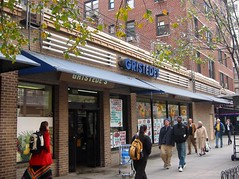Grocery store necessary for walkable communities and commercial districts
 Conor Coakley lives at the Bridgeview apartments in Cleveland's Warehouse District and shops at Constantino's, an upscale grocery on the ground floor of the building. Photo: WKSU.ORG.
Conor Coakley lives at the Bridgeview apartments in Cleveland's Warehouse District and shops at Constantino's, an upscale grocery on the ground floor of the building. Photo: WKSU.ORG.The Salt Lake Tribune reports on a lower-income neighborhood (I didn't know they had any) in Salt Lake City, West Capitol Hill, in "Mission: Market--West Capitol Hill needs a grocery store in a bad way." From the article:
The area has recovered from the 1970s, when it was considered a borderline slum by many, but still struggles to attract a grocer. It's part of a national trend called "the grocery gap." There are a third fewer supermarkets in low-income neighborhoods than middle-class or affluent ones because grocery retailers find the customer base less attractive, according to a study by the Food Marketing Policy Center at the University of Connecticut.
Inner-city neighborhoods, such as West Capitol Hill, often have a few convenience stores with a small selection of processed foods but limited access to fresh produce, causing some public health advocates to worry about the diets of those who cannot afford to own cars and drive to grocery stores. Grocery shopping for low-income residents can require carrying bulky bags on the bus or taking an expensive taxicab ride to the store, leaving many to opt for buying food from mini-marts or fast-food chains.
Community activists have tried organizing a farmers market or a small food cooperative in West Capitol Hill without success, but now an effort by Salt Lake City's Redevelopment Agency might bring in the Holy Grail: a grocery store.
 This version of Sun Flower Markets has stores in Arizona, Colorado, New Mexico, and Nevada. Photo from their website.
This version of Sun Flower Markets has stores in Arizona, Colorado, New Mexico, and Nevada. Photo from their website.
"In order to make progress toward a walkable community, a grocery store is . . . a critical element," says Dave Oka, director of Salt Lake City's Redevelopment Agency. "We've felt for a very long time that that is a missing component in the West Capitol Hill area."
The answer really, is rightsizing.
If your answer is a 65,000 to 130,000 s.f. grocery store, emerging inner city neighborhoods have no chance. But a great grocery store can be produced in 15,000 s.f. to 25,000 s.f., if Colorado-based Sun Flower Market, Indianapolis-based Sunflower Markets (not affiliated with the other, and owned in fact, by Supervalu), the Fresh Market upscale stores based in North Carolina, as well as a plethora of independents, such as the Urban Market in Dallas, Fox and Obel in Chicago, Harvest Urban Market in San Francisco, and Constantino's in Cleveland are the models adopted, rather than suburban big box formats.
Of course, stores like D'Agostinos and Gristedes in New York City showed the way long before.
 Gristedes Market below 9th Sreet, Manhattan (University Place neighborhood. Photo by Hubert Steed (check out his other photos).
Gristedes Market below 9th Sreet, Manhattan (University Place neighborhood. Photo by Hubert Steed (check out his other photos).Index Keywords: urban-revitalization



0 Comments:
Post a Comment
<< Home